\(y_1 = \sin \theta\)
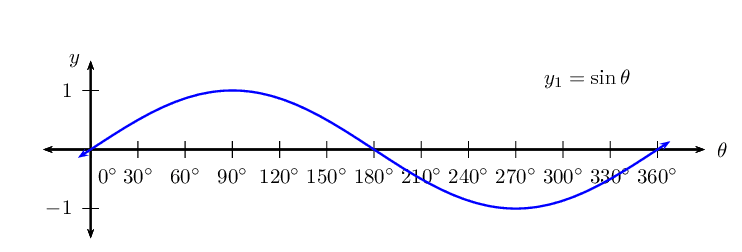

We think you are located in United States. Is this correct?
We use this information to present the correct curriculum and to personalise content to better meet the needs of our users.
|
Previous
5.4 Exponential functions
|
Next
5.6 The cosine function
|

Period of one complete wave is \(\text{360}\)\(\text{°}\).
Amplitude is the maximum height of the wave above and below the \(x\)-axis and is always positive. Amplitude = \(\text{1}\).
Domain: \([\text{0}\text{°};\text{360}\text{°}]\)
For \(y = \sin \theta\), the domain is \(\{ \theta: \theta \in \mathbb{R} \}\), however in this case, the domain has been restricted to the interval \(\text{0}\text{°} \leq \theta \leq \text{360}\text{°}\).
Range: \(\left[-1;1\right]\)
\(x\)-intercepts: \(\left(\text{0}\text{°};0\right)\), \(\left(\text{180}\text{°};0\right)\), \(\left(\text{360}\text{°};0\right)\)
\(y\)-intercept: \(\left(\text{0}\text{°};0\right)\)
Maximum turning point: \(\left(\text{90}\text{°};1\right)\)
Minimum turning point: \(\left(\text{270}\text{°};-1\right)\)
The effects of \(a\) and \(q\) on \(f(\theta) = a \sin \theta + q\):
The effect of \(q\) on vertical shift
For \(q>0\), \(f(\theta)\) is shifted vertically upwards by \(q\) units.
For \(q<0\), \(f(\theta)\) is shifted vertically downwards by \(q\) units.
The effect of \(a\) on shape
For \(a>1\), the amplitude of \(f(\theta)\) increases.
For \(0<a<1\), the amplitude of \(f(\theta)\) decreases.
For \(a<0\), there is a reflection about the \(x\)-axis.
For \(-1 < a < 0\), there is a reflection about the \(x\)-axis and the amplitude decreases.
For \(a < -1\), there is a reflection about the \(x\)-axis and the amplitude increases.
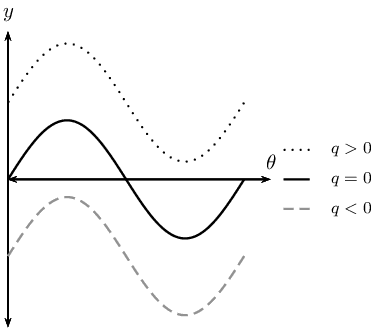
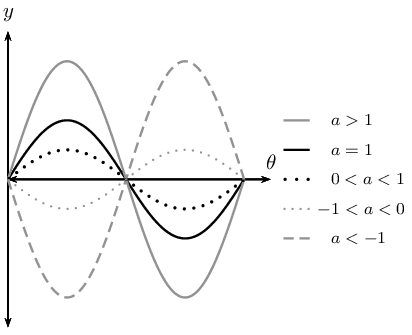
On separate axes, accurately draw each of the following functions for \(\text{0}\text{°} \leq \theta \leq \text{360}\text{°}\).
For each function also determine the following:
\(y_1 = \sin \theta\)

\(y_2 = - 2 \sin \theta\)
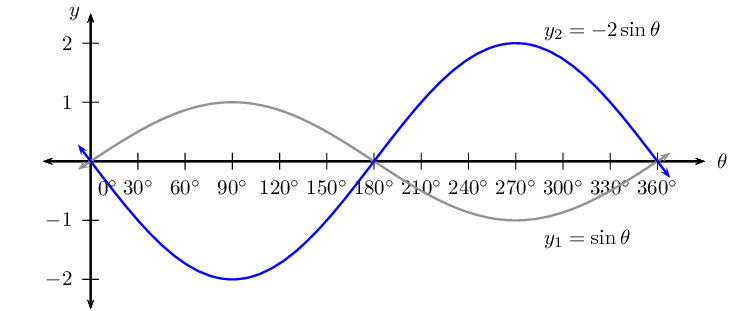
\(y_3 = \sin \theta + 1\)
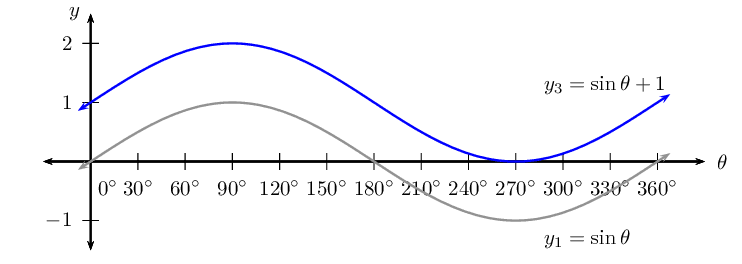
\(y_4 = \frac{1}{2} \sin \theta - 1\)
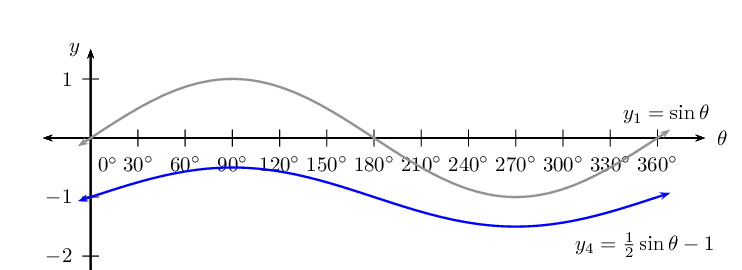
| \(θ\) | \(-\text{360}\)\(\text{°}\) | \(-\text{270}\)\(\text{°}\) | \(-\text{180}\)\(\text{°}\) | \(-\text{90}\)\(\text{°}\) | \(\text{0}\)\(\text{°}\) | \(\text{90}\)\(\text{°}\) | \(\text{180}\)\(\text{°}\) | \(\text{270}\)\(\text{°}\) | \(\text{360}\)\(\text{°}\) |
| \(\sin \theta\) |
Use the table of values to plot the graph of \(y_1 = \sin \theta\) for \(-\text{360}\text{°} \leq \theta \leq \text{360}\text{°}\).
On the same system of axes, plot the following graphs:
Use your sketches of the functions above to complete the following table:
| \(y_1\) | \(y_2\) | \(y_3\) | \(y_4\) | |
| period | ||||
| amplitude | ||||
| domain | ||||
| range | ||||
| maximum turning points | ||||
| minimum turning points | ||||
| \(y\)-intercept(s) | ||||
| \(x\)-intercept(s) | ||||
| effect of \(k\) |
What do you notice about \(y_1 = \sin \theta\) and \(y_2 = \sin (-\theta)\)?
Is \(\sin (-\theta) = -\sin \theta\) a true statement? Explain your answer.
The effect of the parameter on \(y = \sin k\theta\)
The value of \(k\) affects the period of the sine function. If \(k\) is negative, then the graph is reflected about the \(y\)-axis.
For \(k > 0\):
For \(k > 1\), the period of the sine function decreases.
For \(0 < k < 1\), the period of the sine function increases.
For \(k < 0\):
For \(-1 < k < 0\), the graph is reflected about the \(y\)-axis and the period increases.
For \(k < -1\), the graph is reflected about the \(y\)-axis and the period decreases.
Negative angles: \[\sin (-\theta) = -\sin \theta\]
Calculating the period:
To determine the period of \(y = \sin k\theta\) we use, \[\text{Period } = \frac{\text{360}\text{°}}{|k|}\] where \(|k|\) is the absolute value of \(k\) (this means that \(k\) is always considered to be positive).
|
\(0 < k < 1\) |
\(-1 < k < 0\) |
 |
 |
|
\(k > 1\) |
\(k < -1\) |
 |
 |
For each function determine the following:
Notice that \(k > 1\) for \(y_2 = \sin \frac{3\theta}{2}\), therefore the period of the graph decreases.
| \(θ\) | \(-\text{180}\)\(\text{°}\) | \(-\text{135}\)\(\text{°}\) | \(-\text{90}\)\(\text{°}\) | \(-\text{45}\)\(\text{°}\) | \(\text{0}\)\(\text{°}\) | \(\text{45}\)\(\text{°}\) | \(\text{90}\)\(\text{°}\) | \(\text{135}\)\(\text{°}\) | \(\text{180}\)\(\text{°}\) |
| \(\sin \theta\) | \(\text{0}\) | \(-\text{0,71}\) | \(-\text{1}\) | \(-\text{0,71}\) | \(\text{0}\) | \(\text{0,71}\) | \(\text{1}\) | \(\text{0,71}\) | \(\text{0}\) |
| \(\sin \frac{3\theta}{2}\) | \(\text{1}\) | \(\text{0,38}\) | \(-\text{0,71}\) | \(-\text{0,92}\) | \(\text{0}\) | \(\text{0,92}\) | \(\text{0,71}\) | \(-\text{0,38}\) | \(-\text{1}\) |

| \(y_1 = \sin \theta\) | \(y_2 = \sin \frac{3\theta}{2}\) | |
| period | \(\text{360}\)\(\text{°}\) | \(\text{240}\)\(\text{°}\) |
| amplitude | \(\text{1}\) | \(\text{1}\) |
| domain | \([-\text{180}\text{°};\text{180}\text{°}]\) | \([-\text{180}\text{°};\text{180}\text{°}]\) |
| range | \([-1;1]\) | \([-1;1]\) |
| maximum turning points | \((\text{90}\text{°};1)\) | \((-\text{180}\text{°};1)\) and \((\text{60}\text{°};1)\) |
| minimum turning points | \((-\text{90}\text{°};-1)\) | \((-\text{60}\text{°};-1) \text{ and } (\text{180}\text{°};1)\) |
| \(y\)-intercept(s) | \((\text{0}\text{°};0)\) | \((\text{0}\text{°};0)\) |
| \(x\)-intercept(s) | \((-\text{180}\text{°};0)\), \((\text{0}\text{°};0)\) and \((\text{180}\text{°};0)\) | \((-\text{120}\text{°};0)\), \((\text{0}\text{°};0)\) and \((\text{120}\text{°};0)\) |
For functions of the general form: \(f(\theta) = y =\sin k\theta\):
Domain and range
The domain is \(\{ \theta: \theta \in \mathbb{R} \}\) because there is no value for \(\theta\) for which \(f(\theta)\) is undefined.
The range is \(\{ f(\theta): -1 \leq f(\theta) \leq 1, f(\theta) \in \mathbb{R} \}\) or \([-1;1]\).
Intercepts
The \(x\)-intercepts are determined by letting \(f(\theta) = 0\) and solving for \(\theta\).
The \(y\)-intercept is calculated by letting \(\theta = \text{0}\text{°}\) and solving for \(f(\theta)\). \begin{align*} y &= \sin k\theta \\ &= \sin \text{0}\text{°} \\ &= 0 \end{align*} This gives the point \((\text{0}\text{°};0)\).
Sketch the following functions for \(-\text{180}\text{°} \leq \theta \leq \text{180}\text{°}\) and for each graph determine:
\(f(\theta) =\sin 3\theta\)

For \(f(\theta) =\sin 3\theta\):
\begin{align*} \text{Period: } & \text{120}\text{°} \\ \text{Amplitude: } & 1 \\ \text{Domain: } & [-\text{180}\text{°};\text{180}\text{°}] \\ \text{Range: } & [-1;1] \\ x\text{-intercepts: } & (-\text{180}\text{°};0); (-\text{120}\text{°};0); (-\text{60}\text{°};0); \\ & (\text{0}\text{°};0); (\text{60}\text{°};0); (\text{120}\text{°};0); (\text{180}\text{°};0) \\ y\text{-intercepts: } & (\text{0}\text{°};0) \\ \text{Max. turning point: } & (-\text{90}\text{°};1); (\text{30}\text{°};1); (\text{150}\text{°};1) \\ \text{Min. turning point: } & (-\text{150}\text{°};-1); (-\text{30}\text{°};-1); (\text{90}\text{°};-1) \end{align*}\(g(\theta) =\sin \frac{\theta}{3}\)

For \(g(\theta) =\sin \frac{\theta}{3}\):
\begin{align*} \text{Period: } & \text{1 080}\text{°} \\ \text{Amplitude: } & 1 \\ \text{Domain: } & [-\text{180}\text{°};\text{180}\text{°}] \\ \text{Range: } & [-\text{0,87};\text{0,87}] \\ x\text{-intercepts: } & \text{ none } \\ y\text{-intercepts: } & (\text{0}\text{°};0) \\ \text{Max. turning point: } & \text{ none } \\ \text{Min. turning point: } & \text{ none } \end{align*}\(h(\theta) = \sin (-2\theta)\)

For \(h(\theta) =\sin (-2\theta)\):
\begin{align*} \text{Period: } & \text{180}\text{°} \\ \text{Amplitude: } & 1 \\ \text{Domain: } & [-\text{180}\text{°};\text{180}\text{°}] \\ \text{Range: } & [-1;1] \\ x\text{-intercepts: } & (-\text{180}\text{°};0); (-\text{90}\text{°};0); (\text{0}\text{°};0); (\text{90}\text{°};0); (\text{180}\text{°};0) \\ y\text{-intercepts: } & (\text{0}\text{°};0) \\ \text{Max. turning point: } & (-\text{45}\text{°};1); (\text{135}\text{°};1) \\ \text{Min. turning point: } & (-\text{135}\text{°};-1); (\text{45}\text{°};-1); \end{align*}\(k(\theta) =\sin \frac{3\theta}{4}\)

For \(k(\theta) =\sin \frac{3\theta}{4}\):
\begin{align*} \text{Period: } & \text{480}\text{°} \\ \text{Amplitude: } & 1 \\ \text{Domain: } & [-\text{180}\text{°};\text{180}\text{°}] \\ \text{Range: } & [-1;1] \\ x\text{-intercepts: } & (\text{0}\text{°};0) \\ y\text{-intercepts: } & (\text{0}\text{°};0) \\ \text{Max. turning point: } & (\text{120}\text{°};1) \\ \text{Min. turning point: } & (-\text{120}\text{°};-1); \end{align*}For each graph of the form \(f(\theta) =\sin k\theta\), determine the value of \(k\):

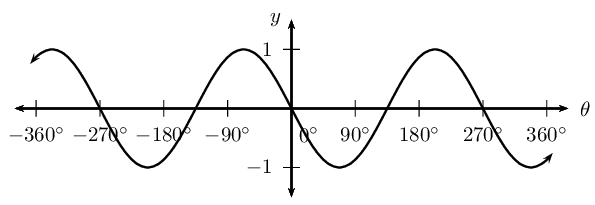
On the same system of axes, plot the following graphs for \(-\text{360}\text{°} \leq \theta \leq \text{360}\text{°}\):
Use your sketches of the functions above to complete the following table:
| \(y_1\) | \(y_2\) | \(y_3\) | \(y_4\) | \(y_5\) | |
| period | |||||
| amplitude | |||||
| domain | |||||
| range | |||||
| maximum turning points | |||||
| minimum turning points | |||||
| \(y\)-intercept(s) | |||||
| \(x\)-intercept(s) | |||||
| effect of \(p\) |
The effect of the parameter on \(y = \sin(\theta + p)\)
The effect of \(p\) on the sine function is a horizontal shift, also called a phase shift; the entire graph slides to the left or to the right.
For \(p > 0\), the graph of the sine function shifts to the left by \(p\).
For \(p < 0\), the graph of the sine function shifts to the right by \(p\).
|
\(p>0\) |
\(p<0\) |
 |
 |
For each function determine the following:
Notice that for \(y_1 = \sin \theta\) we have \(p = 0\) (no phase shift) and for \(y_2 = \sin (\theta - \text{30}\text{°})\), \(p < 0\) therefore the graph shifts to the right by \(\text{30}\text{°}\).
| θ | \(-\text{360}\)\(\text{°}\) | \(-\text{270}\)\(\text{°}\) | \(-\text{180}\)\(\text{°}\) | \(-\text{90}\)\(\text{°}\) | \(\text{0}\)\(\text{°}\) | \(\text{90}\)\(\text{°}\) | \(\text{180}\)\(\text{°}\) | \(\text{270}\)\(\text{°}\) | \(\text{360}\)\(\text{°}\) |
| \(\sin \theta\) | \(\text{0}\) | \(\text{1}\) | \(\text{0}\) | \(-\text{1}\) | \(\text{0}\) | \(\text{1}\) | \(\text{0}\) | \(-\text{1}\) | \(\text{0}\) |
| \(\sin(\theta - \text{30}\text{°})\) | \(-\text{0,5}\) | \(\text{0,87}\) | \(\text{0,5}\) | \(-\text{0,87}\) | \(-\text{0,5}\) | \(\text{0,87}\) | \(\text{0,5}\) | \(-\text{0,87}\) | \(-\text{0,5}\) |
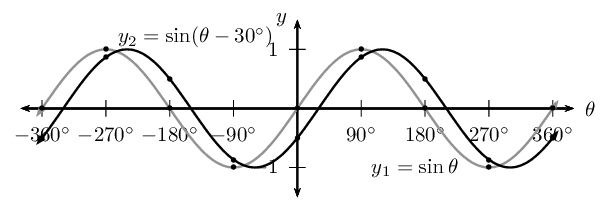
| \(y_1 = \sin \theta\) | \(y_2 = \sin (\theta - \text{30}\text{°})\) | |
| period | \(\text{360}\text{°}\) | \(\text{360}\text{°}\) |
| amplitude | \(\text{1}\) | \(\text{1}\) |
| domain | \([-\text{360}\text{°};\text{360}\text{°}]\) | \([-\text{360}\text{°};\text{360}\text{°}]\) |
| range | \([-1;1]\) | \([-1;1]\) |
| maximum turning points | \((-\text{270}\text{°};1)\) and \((\text{90}\text{°};1)\) | \((-\text{240}\text{°};1)\) and \((\text{120}\text{°};1)\) |
| minimum turning points | \((-\text{90}\text{°};-1)\) and \((\text{270}\text{°};-1)\) | \((-\text{60}\text{°};-1)\) and \((\text{300}\text{°};-1)\) |
| \(y\)-intercept(s) | \((\text{0}\text{°};0)\) | \((\text{0}\text{°};-\frac{1}{2})\) |
| \(x\)-intercept(s) | \((-\text{360}\text{°};0)\), \((-\text{180}\text{°};0)\), \((\text{0}\text{°};0)\), \((\text{180}\text{°};0)\) and \((\text{360}\text{°};0)\) | \((-\text{330}\text{°};0)\), \((-\text{150}\text{°};0)\), \((\text{30}\text{°};0)\) and \((\text{210}\text{°};0)\) |
For functions of the general form: \(f(\theta) = y =\sin (\theta + p)\):
Domain and range
The domain is \(\{ \theta: \theta \in \mathbb{R} \}\) because there is no value for \(\theta\) for which \(f(\theta)\) is undefined.
The range is \(\{ f(\theta): -1 \leq f(\theta) \leq 1, f(\theta) \in \mathbb{R} \}\).
Intercepts
The \(x\)-intercepts are determined by letting \(f(\theta) = 0\) and solving for \(\theta\).
The \(y\)-intercept is calculated by letting \(\theta = \text{0}\text{°}\) and solving for \(f(\theta)\).
Sketch the following functions for \(-\text{360}\text{°} \leq \theta \leq \text{360}\text{°}\).
For each function, determine the following:
\(f(\theta) =\sin (\theta + \text{30}\text{°})\)

For \(f(\theta) =\sin (\theta + \text{30}\text{°})\):
\begin{align*} \text{Period: } & \text{360}\text{°} \\ \text{Amplitude: } & 1 \\ \text{Domain: } & [-\text{360}\text{°};\text{360}\text{°}] \\ \text{Range: } & [-1;1] \\ x\text{-intercepts: } & (-\text{210}\text{°};0); (-\text{30}\text{°};0); (\text{150}\text{°};0); (\text{330}\text{°};0) \\ y\text{-intercepts: } & (\text{0}\text{°};\frac{1}{2}) \\ \text{Max. turning point: } & (-\text{300}\text{°};1); (\text{60}\text{°};1) \\ \text{Min. turning point: } & (-\text{120}\text{°};-1); (\text{240}\text{°};-1) \end{align*}\(g(\theta) =\sin (\theta - \text{45}\text{°})\)

For \(g(\theta) =\sin (\theta - \text{45}\text{°})\):
\begin{align*} \text{Period: } & \text{360}\text{°} \\ \text{Amplitude: } & 1 \\ \text{Domain: } & [-\text{360}\text{°};\text{360}\text{°}] \\ \text{Range: } & [-1;1] \\ x\text{-intercepts: } & (-\text{315}\text{°};0); (-\text{135}\text{°};0); (\text{45}\text{°};0); (\text{225}\text{°};0) \\ y\text{-intercepts: } & (\text{0}\text{°};\frac{1}{\sqrt{2}}) \\ \text{Max. turning point: } & (-\text{300}\text{°};1); (-\text{225}\text{°};1) ; (\text{135}\text{°};1) \\ \text{Min. turning point: } & (-\text{45}\text{°};-1); (\text{315}\text{°};-1) \end{align*}\(h(\theta) =\sin (\theta + \text{60}\text{°})\)

For \(h(\theta) =\sin (\theta + \text{60}\text{°})\):
\begin{align*} \text{Period: } & \text{360}\text{°} \\ \text{Amplitude: } & 1 \\ \text{Domain: } & [-\text{360}\text{°};\text{360}\text{°}] \\ \text{Range: } & [-1;1] \\ x\text{-intercepts: } & (-\text{240}\text{°};0); (-\text{60}\text{°};0); (\text{120}\text{°};0); (\text{300}\text{°};0) \\ y\text{-intercepts: } & (\text{0}\text{°};\frac{\sqrt{3}}{2}) \\ \text{Max. turning point: } & (-\text{300}\text{°};1); (-\text{330}\text{°};1) ; (\text{30}\text{°};1) \\ \text{Min. turning point: } & (-\text{150}\text{°};-1); (\text{210}\text{°};-1) \end{align*}Sketch the graph of \(f(\theta) = \sin (\text{45}\text{°} - \theta)\) for \(\text{0}\text{°} \leq \theta \leq \text{360}\text{°}\).
Write the equation in the form \(y = \sin (\theta + p)\).
\begin{align*} f(\theta) &= \sin (\text{45}\text{°} - \theta)\\ &= \sin (-\theta + \text{45}\text{°}) \\ &= \sin \left( -(\theta - \text{45}\text{°}) \right) \\ &= -\sin (\theta - \text{45}\text{°}) \end{align*}To draw a graph of the above function, we know that the standard sine graph, \(y = \sin\theta\), must:
| θ | \(\text{0}\)\(\text{°}\) | \(\text{45}\)\(\text{°}\) | \(\text{90}\)\(\text{°}\) | \(\text{135}\)\(\text{°}\) | \(\text{180}\)\(\text{°}\) | \(\text{225}\)\(\text{°}\) | \(\text{270}\)\(\text{°}\) | \(\text{315}\)\(\text{°}\) | \(\text{360}\)\(\text{°}\) |
| \(f(\theta)\) | \(\text{0,71}\) | \(\text{0}\) | \(-\text{0,71}\) | \(-\text{1}\) | \(-\text{0,71}\) | \(\text{0}\) | \(\text{0,71}\) | \(\text{1}\) | \(\text{0,71}\) |

Period: \(\text{360}\text{°}\)
Amplitude: \(\text{1}\)
Domain: \([-\text{360}\text{°};\text{360}\text{°}]\)
Range: \([-1;1]\)
Maximum turning point: \((\text{315}\text{°};1)\)
Minimum turning point: \((\text{135}\text{°};-1)\)
\(y\)-intercepts: \((\text{0}\text{°};\text{0,71})\)
\(x\)-intercept: \((\text{45}\text{°};0) \text{ and } (\text{225}\text{°};0)\)
Sketch the graph of \(f(\theta) = \sin (3\theta + \text{60}\text{°})\) for \(\text{0}\text{°} \leq \theta \leq \text{180}\text{°}\).
Write the equation in the form \(y = \sin k(\theta + p)\).
\begin{align*} f(\theta) &= \sin (3\theta + \text{60}\text{°})\\ &= \sin 3(\theta + \text{20}\text{°}) \end{align*}To draw a graph of the above equation, the standard sine graph, \(y = \sin\theta\), must be changed in the following ways:
| θ | \(\text{0}\)\(\text{°}\) | \(\text{30}\)\(\text{°}\) | \(\text{60}\)\(\text{°}\) | \(\text{90}\)\(\text{°}\) | \(\text{120}\)\(\text{°}\) | \(\text{150}\)\(\text{°}\) | \(\text{180}\)\(\text{°}\) |
| \(f(\theta)\) | \(\text{0,87}\) | \(\text{0,5}\) | \(-\text{0,87}\) | \(-\text{0,5}\) | \(\text{0,87}\) | \(\text{0,5}\) | \(-\text{0,87}\) |

Period: \(\text{120}\text{°}\)
Amplitude: \(\text{1}\)
Domain: \([\text{0}\text{°}; \text{180}\text{°}]\)
Range: \([-1;1]\)
Maximum turning point: \((\text{10}\text{°}; 1) \text{ and } (\text{130}\text{°}; 1)\)
Minimum turning point: \((\text{70}\text{°}; -1)\)
\(y\)-intercept: \((\text{0}\text{°}; \text{0,87})\)
\(x\)-intercepts: \((\text{40}\text{°}; 0)\), \((\text{100}\text{°}; 0)\) and \((\text{160}\text{°}; 0)\)
Sketch the following graphs on separate axes:
\(y = 2 \sin \frac{\theta}{2}\) for \(-\text{360}\text{°} \leq \theta \leq \text{360}\text{°}\)

\(f(\theta) = \frac{1}{2} \sin (\theta - \text{45}\text{°})\) for \(-\text{90}\text{°} \leq \theta \leq \text{90}\text{°}\)
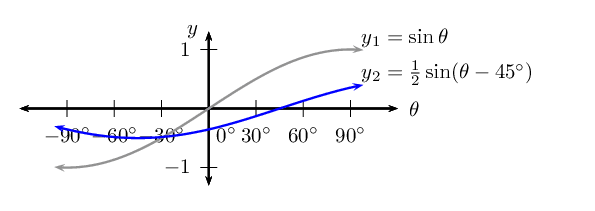
\(y = \sin (\theta + \text{90}\text{°}) + 1\) for \(\text{0}\text{°} \leq \theta \leq \text{360}\text{°}\)

\(y = \sin (-\frac{3\theta}{2})\) for \(-\text{180}\text{°} \leq \theta \leq \text{180}\text{°}\)

\(y = \sin (\text{30}\text{°} - \theta)\) for \(-\text{360}\text{°} \leq \theta \leq \text{360}\text{°}\)

Given the graph of the function \(y = a \sin (\theta + p)\), determine the values of \(a\) and \(p\).
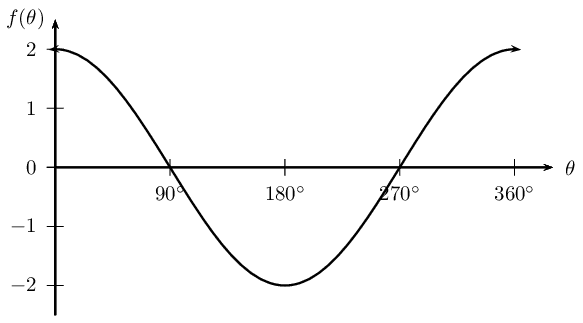
Can you describe this graph in terms of \(\cos \theta\)?
|
Previous
5.4 Exponential functions
|
Table of Contents |
Next
5.6 The cosine function
|